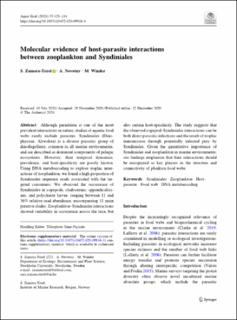| dc.description.abstract | Although parasitism is one of the most prevalent interactions in nature, studies of aquatic food webs rarely include parasites. Syndiniales (Dinophyceae, Alveolata) is a diverse parasitic group of dinoflagellates, common in all marine environments, and are described as dominant components of pelagic ecosystems. However, their temporal dynamics, prevalence, and host-specificity are poorly known. Using DNA metabarcoding to explore trophic interactions of zooplankton, we found a high proportion of Syndiniales sequence reads associated with the targeted consumers. We observed the occurrence of Syndiniales in copepods, cladocerans, appendicularians, and polychaete larvae, ranging between 11 and 36% relative read abundance, encompassing 11 main putative clades. Zooplankton–Syndiniales interactions showed variability in occurrence across the taxa, but also certain host-specificity. The study suggests that the observed copepod–Syndiniales interactions can be both direct parasitic infections and the result of trophic transmission through potentially infected prey by Syndiniales. Given the quantitative importance of Syndiniales and zooplankton in marine environments, our findings emphasize that their interactions should be recognized as key players in the structure and connectivity of plankton food webs. | en_US |
